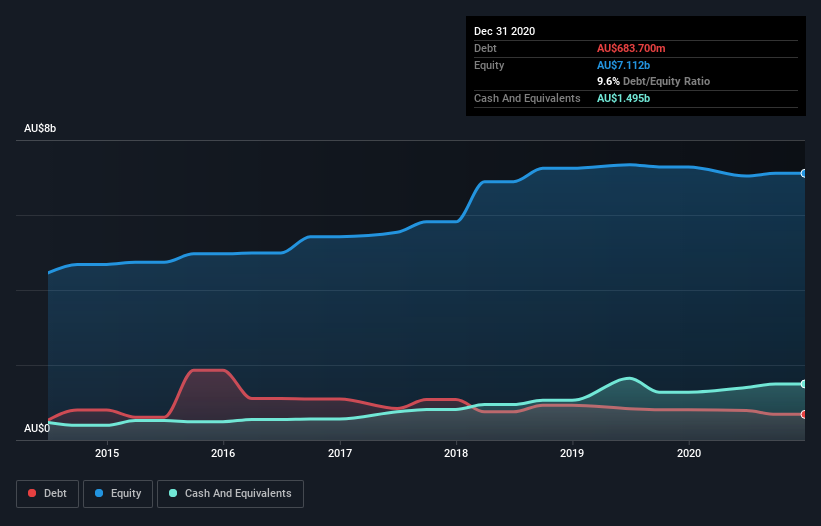Does BlueScope Steel (ASX:BSL) Have A Healthy Balance Sheet?
David Iben put it well when he said, 'Volatility is not a risk we care about. What we care about is avoiding the permanent loss of capital.' So it might be obvious that you need to consider debt, when you think about how risky any given stock is, because too much debt can sink a company. We can see that BlueScope Steel Limited (ASX:BSL) does use debt in its business. But the more important question is: how much risk is that debt creating?
When Is Debt Dangerous?
Debt assists a business until the business has trouble paying it off, either with new capital or with free cash flow. Part and parcel of capitalism is the process of 'creative destruction' where failed businesses are mercilessly liquidated by their bankers. However, a more common (but still painful) scenario is that it has to raise new equity capital at a low price, thus permanently diluting shareholders. By replacing dilution, though, debt can be an extremely good tool for businesses that need capital to invest in growth at high rates of return. The first step when considering a company's debt levels is to consider its cash and debt together.
Check out our latest analysis for BlueScope Steel
How Much Debt Does BlueScope Steel Carry?
You can click the graphic below for the historical numbers, but it shows that BlueScope Steel had AU$683.7m of debt in December 2020, down from AU$804.7m, one year before. But it also has AU$1.50b in cash to offset that, meaning it has AU$811.4m net cash.
A Look At BlueScope Steel's Liabilities
Zooming in on the latest balance sheet data, we can see that BlueScope Steel had liabilities of AU$2.43b due within 12 months and liabilities of AU$1.79b due beyond that. Offsetting these obligations, it had cash of AU$1.50b as well as receivables valued at AU$1.04b due within 12 months. So its liabilities outweigh the sum of its cash and (near-term) receivables by AU$1.68b.
Of course, BlueScope Steel has a market capitalization of AU$10.1b, so these liabilities are probably manageable. Having said that, it's clear that we should continue to monitor its balance sheet, lest it change for the worse. Despite its noteworthy liabilities, BlueScope Steel boasts net cash, so it's fair to say it does not have a heavy debt load!
But the other side of the story is that BlueScope Steel saw its EBIT decline by 7.4% over the last year. That sort of decline, if sustained, will obviously make debt harder to handle. The balance sheet is clearly the area to focus on when you are analysing debt. But it is future earnings, more than anything, that will determine BlueScope Steel's ability to maintain a healthy balance sheet going forward. So if you want to see what the professionals think, you might find this free report on analyst profit forecasts to be interesting.
But our final consideration is also important, because a company cannot pay debt with paper profits; it needs cold hard cash. While BlueScope Steel has net cash on its balance sheet, it's still worth taking a look at its ability to convert earnings before interest and tax (EBIT) to free cash flow, to help us understand how quickly it is building (or eroding) that cash balance. Over the most recent three years, BlueScope Steel recorded free cash flow worth 77% of its EBIT, which is around normal, given free cash flow excludes interest and tax. This cold hard cash means it can reduce its debt when it wants to.
Summing up
Although BlueScope Steel's balance sheet isn't particularly strong, due to the total liabilities, it is clearly positive to see that it has net cash of AU$811.4m. The cherry on top was that in converted 77% of that EBIT to free cash flow, bringing in AU$543m. So we don't have any problem with BlueScope Steel's use of debt. There's no doubt that we learn most about debt from the balance sheet. But ultimately, every company can contain risks that exist outside of the balance sheet. For example, we've discovered 3 warning signs for BlueScope Steel that you should be aware of before investing here.
Of course, if you're the type of investor who prefers buying stocks without the burden of debt, then don't hesitate to discover our exclusive list of net cash growth stocks, today.
This article by Simply Wall St is general in nature. It does not constitute a recommendation to buy or sell any stock, and does not take account of your objectives, or your financial situation. We aim to bring you long-term focused analysis driven by fundamental data. Note that our analysis may not factor in the latest price-sensitive company announcements or qualitative material. Simply Wall St has no position in any stocks mentioned.
Have feedback on this article? Concerned about the content? Get in touch with us directly. Alternatively, email editorial-team (at) simplywallst.com.

 Yahoo Finance
Yahoo Finance 
